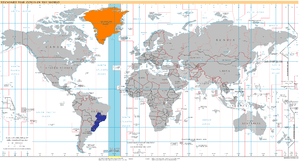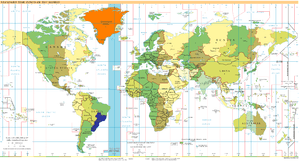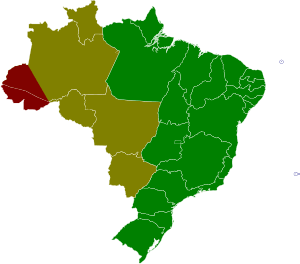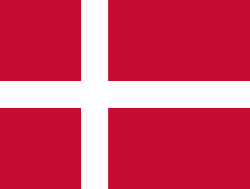UTC−02:00
UTC−02:00 is an identifier for a time offset from UTC of −02:00.
| UTC−02:00 | |
|---|---|
 World map with the time zone highlighted | |
| UTC offset | |
| UTC | UTC−02:00 |
| Current time | |
| 19:39, 12 August 2020 UTC−02:00 [refresh] | |
| Central meridian | |
| 30 degrees W | |
| Date-time group | |
| O | |

UTC−02:00: blue (January), orange (July), yellow (all year round), light blue (sea areas)

Time in Brazil, since April 26, 2019.
| ACT | Acre Time | UTC−5 | (BRT–2) | |
| AMT | Amazon Time | UTC−4 | (BRT−1) | |
| BRT | Brasilia Time | UTC−3 | (BRT) | |
| FNT | Fernando de Noronha Time | UTC−2 | (BRT+1) |
As daylight saving time (Northern Hemisphere summer)
North America

- Greenland[1]
- Except areas around Danmarkshavn, Ittoqqortoormiit and Pituffik (Thule)
- Greenland[1]

As standard time (all year round)
Atlantic Ocean
gollark: Electron > Qt for ease of development, Electron <<<< Qt for performance.
gollark: You probably *can*.
gollark: Are you just going to frame *anything I say* as "he is clearly evil and must be destroyed"?
gollark: It got there because of, seemingly, some weird inexplicable bug.
gollark: ss13?
See also
- Time in Brazil
- Time in Denmark
References
- "How far is it from Qaanaaq to locations worldwide". timeanddate.com. Retrieved 24 April 2014.
- "Current Time Zone". Brazil Considers Having Only One Time Zone. Time and Date. 21 July 2009. Retrieved 14 July 2012.
This article is issued from Wikipedia. The text is licensed under Creative Commons - Attribution - Sharealike. Additional terms may apply for the media files.